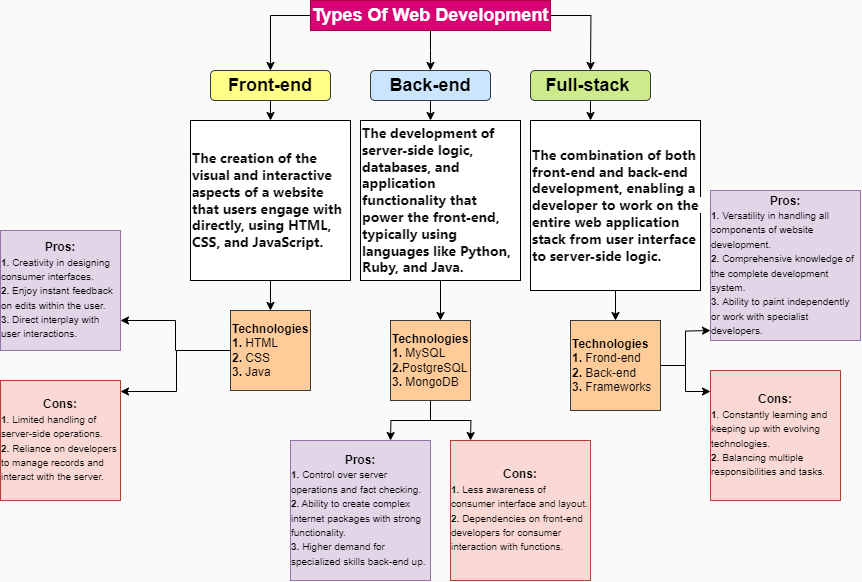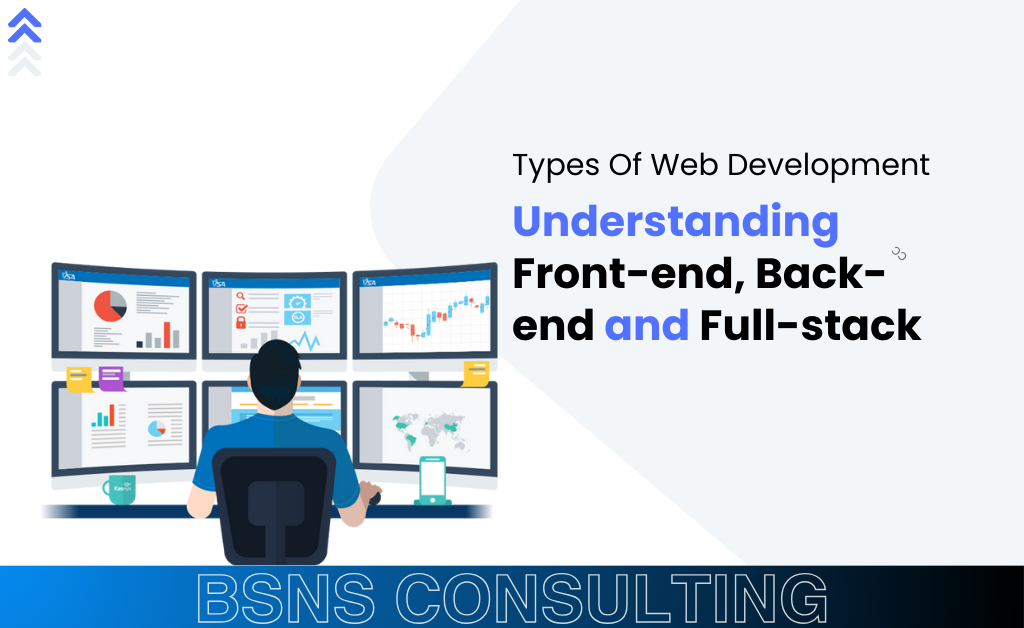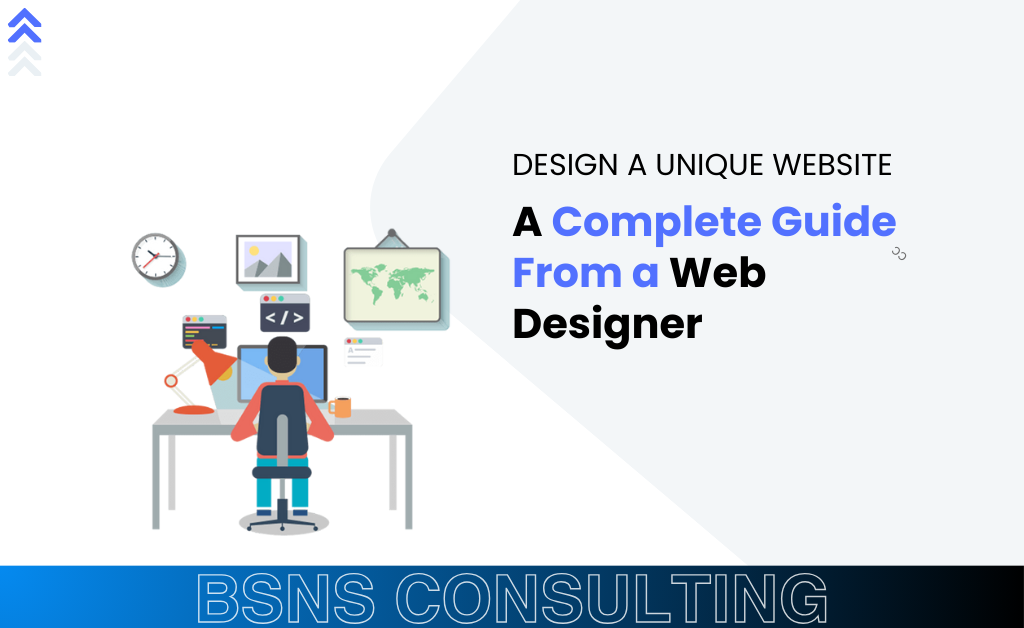Web development is the work related to the development of web pages and website packages. It plays a key role in our virtual international company. Without the advancement of the internet, we wouldn’t have the websites and apps we use every day. There are unique types of web development, each focusing on precise duties and competencies. In this publication, we’ll discover developments to the front-end, back-end, and the full stack. Understanding these types of web development can help you make a decision which path to follow or what abilities to look for whilst hiring a web developer.

What is front-end development❓
Front-end development is the part of web development that makes a specialty of creating the visible elements of web pages. This is what customers see and engage with once they go to the domain. The basic goal of front-end development is to ensure that websites are user-friendly, visually appealing, and run smoothly. This area combines design and programming to create a continuous person who enjoys.
Front-end developers use numerous types of web development technologies to create the front end of a website:
- HTML (HyperText Markup Language): This is the usual markup language used to create the structure of web pages. HTML factors form the building blocks of all web pages.
- CSS (Cascading Style Sheets): CSS is used to style HTML factors. It controls the layout, shades, fonts and trendy appearance of the website so it appears sleek and visually appealing.
- JavaScript: This is a scripting language that enables interactive features on web pages. Using JavaScript, creators can create dynamic content consisting of bureaucracy that validates consumer input, presentations, and interactive maps.
In addition to these core technologies, developers often use frameworks and libraries to simplify and speed up types of web developmenttechniques. Some popular front-end frameworks and libraries consist of:
- React: Developed by using Facebook, React is a library for building purchaser interfaces. It lets in developers to create reusable UI components, making code greater modular and much less complex to keep.
- Angular: Managed by Google, Angular is a comprehensive framework for building dynamic web pages. It provides a robust set of facilities and functions for developing complex programs.
- Vue.Js: Vue.Js is a revolutionary framework for building personal interfaces. It is designed to be adaptable and can be incorporated into tasks incrementally, making it a flexible preference for developers working in different types of web development.
Front-end development also means making sure that websites are responsive and paint correctly on a variety of devices, from computer systems to smartphones. This is accomplished using responsive design strategies and frameworks such as Bootstrap that provide pre-built components and patterns for creating responsive layouts in types of web development especially front-end.
Having a robust development team is vital for digital marketing consultancy Islamabad, especially those dealing with virtual advertising consultancy. A properly designed website can significantly beautify people’s engagement and make business boom. If you’re located in the area, a good digital marketing consultancy Islamabad like BSNS Consulting, can greatly benefit from top-notch front-end development and create enticing and powerful online presentations for their clients.
What is Back-End Development❓
Website development company
Back-end development is one of the types of web development that specialises in server common sense and database management. It’s what happens behind the scenes when a user interacts with a website. While front-end developments in a website development company typically offer visual factors, back-end development ensures that the whole works easily and securely on the server side.
Back-end developers use a variety of technologies and languages to build and maintain the server, software and database. Some common back-end languages include:
- PHP: A well-known scripting language that is mainly beneficial for net application development and may be embedded in HTML.
- Python: Known for its clarity and ease, Python is extensively utilised in net development, especially with frameworks like Django and Flask.
- Java: A robust and widely used programming language often used in large enterprise packages in common types of web development.
- Ruby: Ruby is often used with the Ruby on Rails framework and is known for its fashionable syntax and productivity.
Backup development also involves using databases to shop and manage statistics. Some common database types of web development technologies include:
- MySQL: An Open Source Relational Database Management Facility.
- PostgreSQL: An efficient, open-source object-relational database engine.
- MongoDB: A NoSQL database that uses JSON-like documents to store records.
In addition to languages and databases, back-end developers use numerous frameworks to build scalable and efficient web packages. These frameworks provide facilities and libraries that simplify development and increase productivity for the types of web development techniques in a website development company. Some popular back-termination frameworks include:
- Express.Js: A minimal and flexible Node.Js web software framework that provides a robust feature set for web and mobile applications.
- Django: It is an advanced Python web framework that facilitates quick development and emphasises clean, practical design.
- Spring: A complete framework for building agency-level packages in Java.
- Ruby on Rails: A server-side web tool framework written in Ruby that follows the MVC (Model-View-Controller) structure.
What is Full-Stack Development❓
Web Designer
A full-stack web designer has work that involves working on every front-end and back-end website application. A full-stack developer has the skills to deal with all aspects of web development, from designing user interfaces to working with good judgement and databases from a server perspective. This role amongst many types of web development requires a range of talents and a vast expertise base.
Definitions and roles
Full-stack developers work both on the patron side (front-give up) and on the server side (back-end) of web development. Their web designer role can be useful and enjoyable for a person. They design the layout and capabilities that users interact with, and manage the data and server operations that support these interactions.
Skills and knowledge
To become a full-stack developer, you need talent in many regions:
- Advance Development: Proficiency in HTML, CSS, and JavaScript is essential. Knowledge of frameworks such as React, Angular or Vue.Js is also essential.
- Back-end development: Understanding of server-side languages such as PHP, Python, Java or Ruby, along with database management using systems such as MySQL, PostgreSQL or MongoDB is imperative for learning types of web development.
- Frameworks: Knowledge of frameworks like Django, Express.Js or Ruby on Rails makes it easy to build robust packages.
- Versioning: Knowledge of versioning systems like Git is essential for collaborating and handling code edits.
Advantages
- Versatility: Full-stack developers can handle multiple elements of the challenge, making them adaptable.
- Comprehensive expertise: They have an overall view of how web applications paint, which helps in green troubleshooting.
- Cost-effective: For small teams or startups, a full-stack developer can be more budget-friendly than hiring individual specialists.
Challenges
- Continuous learning: The subject of website development evolves unexpectedly and requires full-stack developers to keep their talents up to date.
- Workload stability: Handling all the front-end and lower back-end tasks can be challenging and time-consuming.
- Depth of Knowledge: While they have a complete skill set, full stack developers may not have the same depth of know-how as specialised developers.
Key differences between front-end, back-end and full-stack development
Skills Web development
Front-end, back-end, and full-stack development are distinct areas of expertise within types of web development. Each type has its own set of skills, duties and technologies. Understanding these variations can help developers choose a course that best suits their pursuits and career dreams.
1. Front-end development
Front-end development focuses on the user interface and the user delights in the website. Front-end developers work on the visual elements that customers interact with, including layouts, buttons, forms, and navigation menus. They use languages like HTML for form, CSS for styling, and JavaScript for interactivity.
Skills and Responsibilities
Front-end developers want talent in design, UI/UX principles, and front-end languages and frameworks. They are responsible for developing responsive and visually appealing websites that can be navigated smoothly.
Technologies Used
HTML, CSS, JavaScript and front-end frameworks like React, Angular or Vue.Js are usually used to improve front-end and types of web development.
Advantages and disadvantages
Pros:
- Creativity in designing consumer interfaces.
- Enjoy instant feedback on edits within the user.
- Direct interplay with user interactions.
Cons:
- Limited handling of server-side operations.
- Reliance on developers to manage records and interact with the server.
2. Back-End development
Back-end development offers the logic of server aspects, database and server operations. Back-end creators take care of the behind-the-scenes functionality of websites, including statistics storage, search and processing. They use server-side languages consisting of PHP, Python, Java or Ruby along with secondary databases including MySQL, PostgreSQL or MongoDB.
Skills and Responsibilities
Backend developers require skills in server programming, database management, and system architecture. They are charged to ensure the security of the facts, scalability and overall performance of the webpacks.
Technologies used
Server-side languages, databases, and back-end frameworks like Django, Express.Js, or Ruby on Rails are not uncommon in low back-end development and other types of web development.
Advantages and disadvantages
Pros:
- Control over server operations and fact checking.
- Ability to create complex internet packages with strong functionality.
- Higher demand for specialised skills back-end up.
Cons:
- Less awareness of consumer interface and layout.
- Dependencies on front-end developers for consumer interaction with functions.
3. Full-Stack development
The full stack development combines front-end and back-end development capabilities. Full-stack developers can paint on all factors of an internet application in almost all types of web development, from designing the consumer interface to mastering server-side operations and databases. They have vast knowledge about the entire development technique.
Skills and Responsibilities
Full-stack developers want talents in both front-end and again-end technologies, along with talents in device structure, management, and troubleshooting. They are responsible for designing, growing and maintaining entire web packages in all types of web development.
Technologies used
A collection of front-end and back-end technologies and frameworks are used in a complete suite development.
Advantages and disadvantages
Pros:
- Versatility in handling all components of website development.
- Comprehensive knowledge of the complete development system.
- Ability to paint independently or work with specialist developers.
Cons:
- Constantly learning and keeping up with evolving technologies.
- Balancing multiple responsibilities and tasks.
Choosing the right path in web development
Factors to consider
When choosing a career in types of web development, selecting the right path can make a big difference in your journey. Several elements to consider:
- Interests and Strengths: Consider your interests and strengths in design, problem solving, common sense, or statistics. Front-end developers excel at growing consumer interfaces, even when developers focus on server-side operations and record management. Full-stack developers revel in a combination of both. Look what types of web development you’re interested in.
- Career Goals: Determine your long-term professional aspirations. Do you need to specialise in a certain region or do you prefer versatility? Specialising in front-end or back-end developments can lead to expertise in this area, although full-stack developers have a broader skill set.
- Market Demand: Explore the job market to capture the call for every form of developer. Some regions may also have greater opportunities for front-end or returned-end creators, while others may value full-time talent.
Tips for beginners
For those new to web development, here are some tips to get you started on your adventure:
- Learn the basics: Get started with the basics of HTML, CSS, and JavaScript. These are core languages for continuous development and provide a stable foundation.
- Explore frameworks: Get to know popular front-end frameworks like React, Angular or Vue.Js and returned frameworks like Django, Express.Js or Ruby on Rails. Frameworks simplify development and are widely used in industry.
- Practice regularly: Practise coding often to improve your competence. Create small projects, experiment with unique technologies, and seek feedback from peers or mentors.
- Online resources: Take advantage of online resources that include tutorials, courses, and coding platforms like Codecademy, Udemy, or freeCodeCamp. These resources offer structured study paths and hands-on practice.
Resources and tools
Use the following resources and equipment to succeed in your preferred path:
- Documentation: Languages, frameworks, and equipment can be found in the authentic documentation. The documentation provides some reasons, examples, and best practices.
- Online communities: Join online communities like Stack Overflow, GitHub, or developer boards. These communities offer help, collaboration opportunities, and access to experienced developers.
- Coding Challenges: Take part in coding challenges and hackathons to hone your skills and fix real international problems. Platforms like LeetCode, HackerRank or Codeforces offer coding challenges and competitions.
- Constant learning: Stay on top of industry features, new technologies and subtle practices. Attend workshops, webinars and network conferences with experts and expand your knowledge.
Conclusion
Deciding on the right path in web development—whether it’s front-end, return-end, or full-stack—depends on elements that include your hobbies, career aspirations, market demand, and path of mastery. Beginners can start by learning the basics, researching frameworks, taking regular training and using online resources. Don’t forget to consider elements like hobbies, career aspirations, market demand, and path to mastery when deciding on your web development adventure.
For those looking for professional and best web development services, it is essential to look for ‘web development services near me’ who offer satisfactory website development services. Web development services include a wide range of services, from designing consumer interfaces to managing server-side operations and databases. By opting for professional web development services near you, you can get some amazing answers tailored to your unique wants and needs.
Ultimately, Internet development is an ever-evolving discipline that provides exciting opportunities for growth and innovation. Whether you are a beginner starting your journey or a commercial company looking for expert quotes, the world of website development offers endless opportunities to grow impressive virtual reviews.




